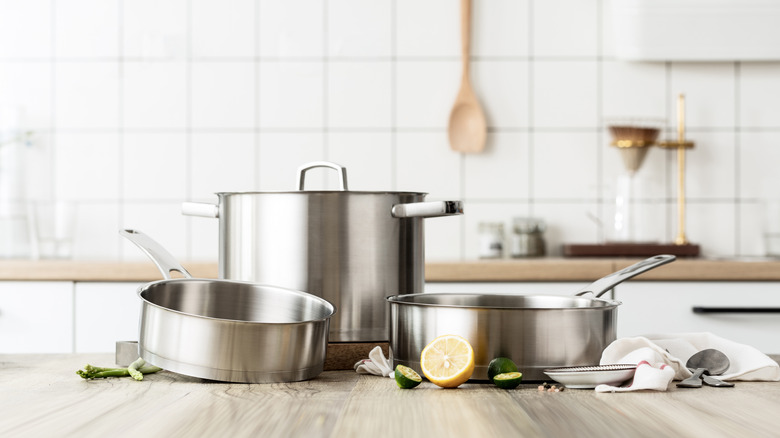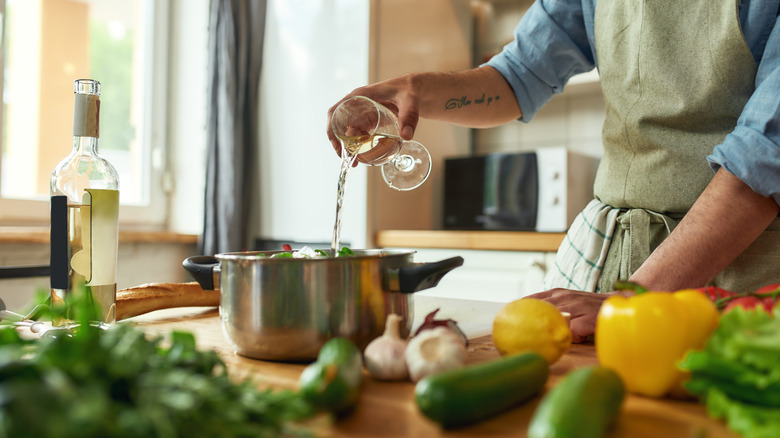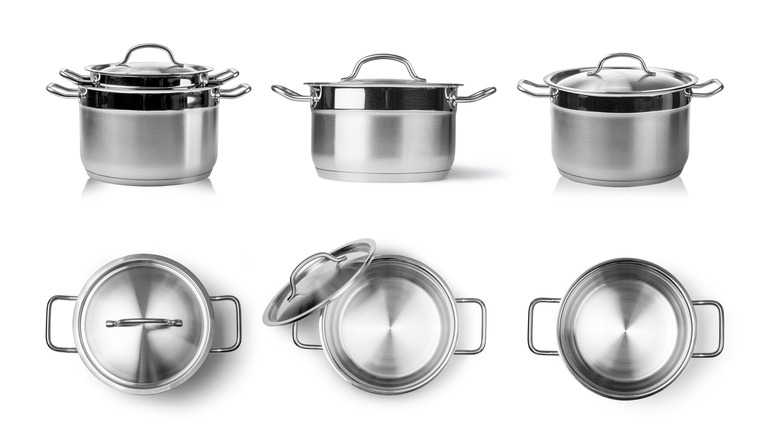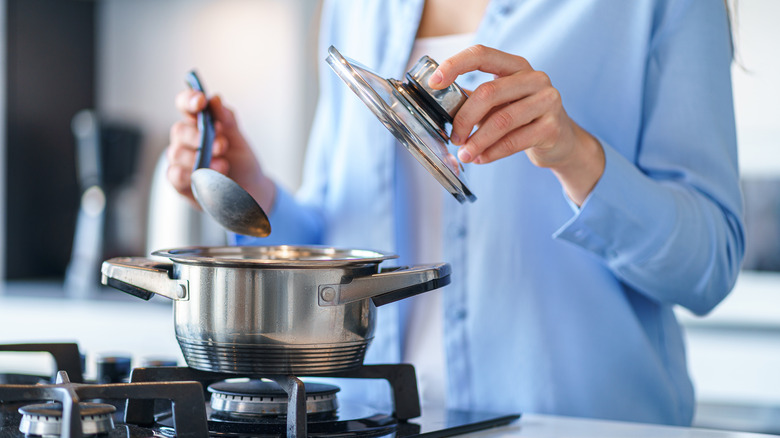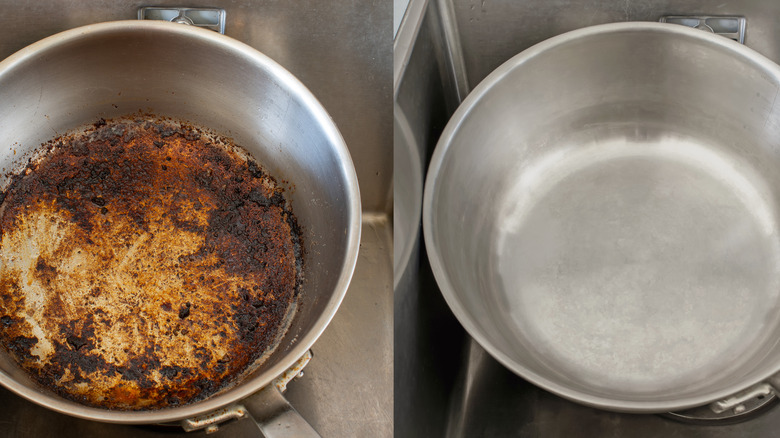Stainless Steel Cookware: Everything You Need To Know Before You Buy
With so many types of cookware to choose from, it's easy for shoppers to become overwhelmed when selecting a style for their kitchens. However, when it comes to versatility, it's hard to beat stainless steel. Stainless steel is frequently used in professional kitchens but is also incredibly useful for home cooks. The Spruce lauds stainless steel for its temperature resistance, durability, and ability to create a delicious sear on meat and vegetables alike. Executive editor of America's Test Kitchen Reviews Lisa McManus told Today, "We love these very sturdy pans for everything from frying to roasting and even baking. With a metal handle, you can put them right in the oven. It's a great basic all-around pan that you can cook almost anything in."
In this article, we'll explore everything you need to know about this cookware staple, including how it compares to other cookware, the benefits, what to use it for, how to clean and maintain it, and what to look for as you shop.
Benefits of stainless steel
If you were to only have one type of cookware in your arsenal, stainless steel would probably be the best choice. It's incredibly versatile and can be used to cook just about anything, according to The Rational Kitchen. For the most part, stainless steel can do pretty much any job that cast iron can do and can take the place of non-stick in many instances as well.
Stainless steel cookware has excellent heat resistance, according to Good Housekeeping, so while it can be used on the stovetop, it's also safe to put in the oven. This makes it easy to get a perfect sear on a steak and then pop it into the oven to ensure the middle reaches a safe temperature. It's important to note that heat resistance does, however, vary from product to product. Look for a model that's heat-resistant up to 500 degrees so it can be used under a broiler. Stainless steel pans are induction-safe and can be used on basically any type of cooktop.
Stainless steel is incredibly durable, and you don't have to be careful about cooking utensils scratching its surface. In fact, if properly maintained, stainless steel cookware can last for decades or even generations.
Multi-ply construction
The best stainless steel pans are multi-ply. This means that they are clad in layers of stainless steel but feature a core made from another metal. Some of the downsides of steel are that it heats up slowly and isn't the best heat conductor. While the mode affordable pans are made solely from stainless steel, higher-quality models combine steel with other metals to achieve a variety of benefits.
The most popular type of core is aluminum, which provides improved heat conductivity. When used alone, aluminum is extremely reactive, according to Wirecutter, meaning it can't be used to cook acidic items like tomatoes. When it's sandwiched between layers of stainless steel, however, cooks get all of the benefits without the reactivity. Another popular choice for the core layer is copper, which has better heat conductivity than any other metal. Pots and pans made with copper are pricier than those made with aluminum. The best versions of multi-clad pans are fully clad, meaning the core extends up the side of the pan. Cheaper options only have a core in the base, which is referred to as an encapsulated bottom.
Typically multi-ply pans will have three layers — a core and two layers of cladding. This style is referred to as tri-ply. Some higher-end models are advertised as being 5-ply or even 7-ply. This style of cookware features multiple layers of steel, though this doesn't necessarily translate to higher quality. These pans have thicker sides, meaning they take longer to heat up and may also be slower to change temperatures.
What do look for in stainless steel cookware
When shopping for stainless steel cookware, there are a few things to consider. First, look at the quality of the steel itself. The Spruce says that stainless steel used for high-quality cookware is typically stamped with a grade of 18/10. This means it's made up of 18% chromium and 10% nickel. This balance ensures the pan's durability and rust resistance. Then, opt for a piece or set that's fully clad, meaning the aluminum or copper core extends up the sides of the pan.
Stainless steel cookware varies when it comes to weight. Some users might like the feel of a heavier pan, while others would prefer a lightweight option that's easier to maneuver. Generally speaking, however, heavier pans are of higher quality and will last longer. You'll have to decide whether you'd prefer cookware with glass or stainless steel lids, according to Century Life, both of which have advantages and disadvantages. Glass lids allow you to monitor your food as its cooking, but even if made from high-quality tempered glass tend to have a maximum heat threshold that's lower than that of stainless steel. While stainless steel lids are opaque, they are usually oven-safe and can withstand the same heat levels as the pans themselves.
Also, be sure to consider the price. A single stainless steel skillet varies widely in price from $30 to $300 according to Serious Eats. Buying a set can be economical, but it's important to ensure that you'll use each piece that's included. Since it's not possible to test the cookware yourself before committing to a purchase, it's important to check reviews for guidance. When shopping online, only consider products that have been well-reviewed by a large number of buyers to ensure high quality and performance.
How to clean stainless steel cookware
Stainless steel is known for being easy to clean, but the term "stainless" may be something of a misnomer. While stainless steel is rust-resistant and shouldn't corrode over time, according to Better Homes & Gardens, it can still discolor. Because it's not non-stick, food can also become burnt on when cooking at high temperatures. One of the benefits of stainless steel is that it can be cleaned in the dishwasher, but while this may be convenient, it's still best to hand wash to ensure the longevity of your cookware.
While the material is durable, there are some things that can have a negative impact. Washing a pan while it's still hot, for example, can cause the steel to warp. Avoid using tools that are particularly abrasive, like steel wool, and harsh cleaning agents like bleach. For everyday cleaning, using warm soapy water and a standard dish brush or sponge should suffice. For stuck-on messes, sprinkle baking soda onto the pan's surface and fill the bottom 2 inches with water. Then bring the mixture to a boil and allow it to simmer until most of the liquid has evaporated. Once the pan has cooled, wash it as usual with a non-abrasive cleaning tool.
